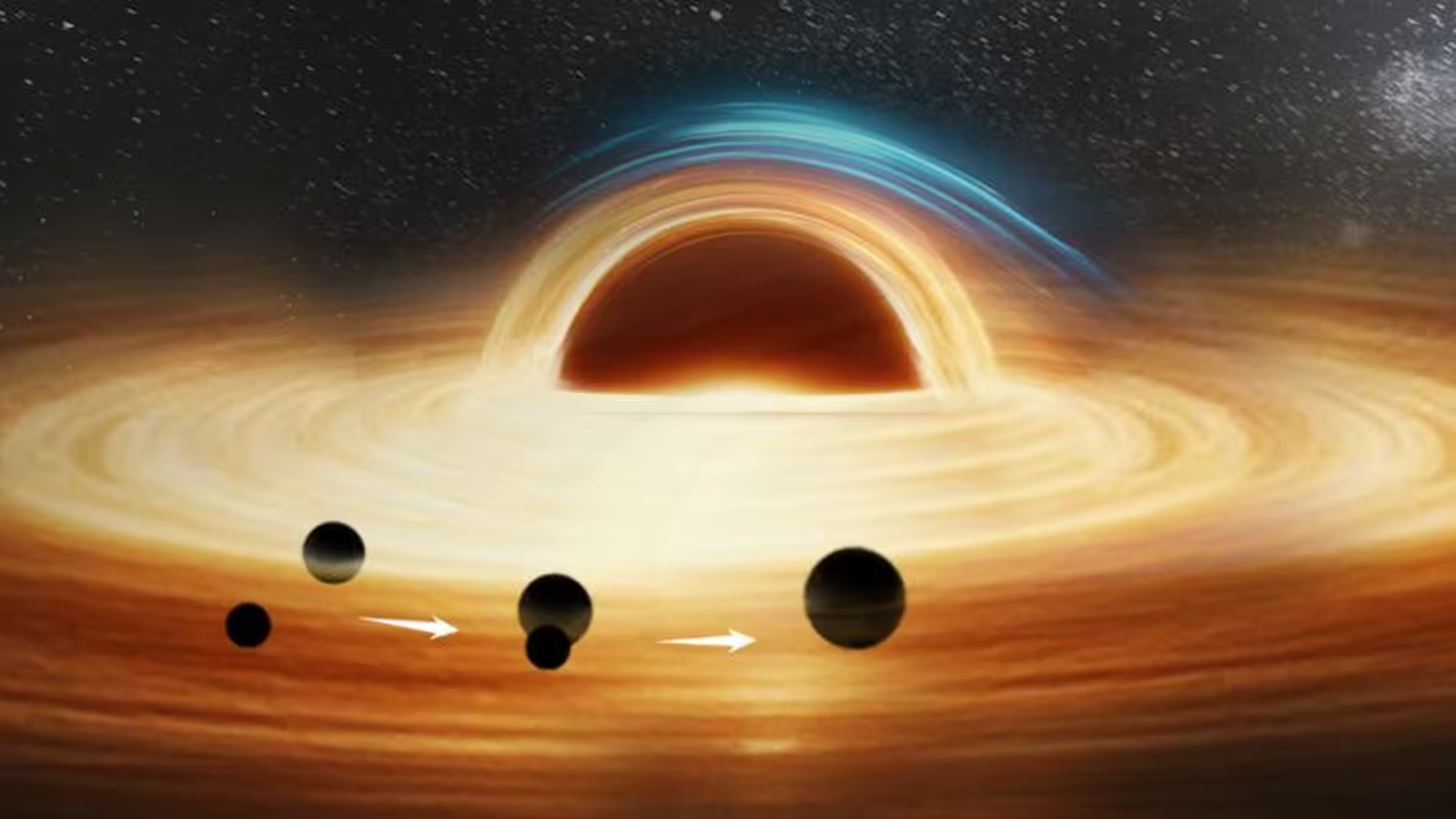5 Minutes
Unusual Acceleration in GW190814 Points to a Third Black Hole
A new reanalysis of gravitational-wave data from the LIGO-Virgo-KAGRA collaboration has revealed an intriguing anomaly in the 2019 event GW190814: an apparent line-of-sight acceleration that could be the first sign of a trinary system of stellar-mass black holes. If confirmed, this would mark the first detection of three compact objects locked in a complex gravitational dance and reshape our understanding of binary formation and hierarchical mergers.
What the Data Shows
Researchers led by Shu-Cheng Yang and collaborators modeled how a binary black hole pair orbiting a more massive third companion would imprint an extra Doppler-like acceleration on the gravitational-wave signal. Their comparison with the GW190814 waveform indicates a line-of-sight acceleration of roughly 0.0015 c (0.15% of light speed) with about 90% confidence, suggesting a third, unseen massive object influenced the binary’s motion.
Astronomer Wen-Biao Han of the Chinese Academy of Sciences summarized the significance: this is the first international evidence consistent with a third compact object in a binary black hole merger event, pointing to non-isolated formation pathways and richer dynamical environments for black hole mergers.
Why GW190814 Stood Out
Unlike many mergers that show evidence of hierarchical growth because one component is more massive than stellar-evolution limits predict, GW190814 involved an unusually light secondary — about 2.6 solar masses — teetering on the boundary between neutron star and black hole, and a primary of roughly 23 solar masses. That extreme mass ratio doesn’t fit standard isolated binary evolution models and prompted a deeper look for alternate formation scenarios, including capture within a multi-body system.
Technology Behind the Discovery: Detectors, Data Processing, and Modeling
Product features and instrumentation:
- LIGO, Virgo and KAGRA detectors: kilometer-scale interferometers with ultra-stable laser interferometry and seismic isolation to pick up strains from gravitational waves.
- Data pipelines and signal processing: advanced matched-filtering algorithms, Bayesian inference engines, and noise-mitigation modules that extract waveform parameters from faint signals.
- High-performance computing (HPC) and machine learning: required for running large parameter-space searches, parameter estimation, and waveform modeling.
Comparisons and strengths:
- LIGO vs. Virgo vs. KAGRA: each observatory contributes unique geographic baselines and detector sensitivity curves, improving sky localization and parameter estimation when combined as a global network.
- Classical matched filtering vs. ML-based searches: matched filtering remains the gold standard for detection confidence, while ML accelerates candidate identification and noise classification.
Advantages of the global network:
- Redundancy and cross-validation of transient candidates.
- Better measurement of subtle effects like line-of-sight acceleration when multiple detectors capture coherent signals.
Implications, Use Cases and Scientific Value
Use cases for this analysis and technology:
- Astrophysics: probing black hole formation channels, cluster dynamics, and hierarchical merger rates.
- Fundamental physics: precision tests of general relativity and modified gravity in strong-field regimes.
- Data science: developing tools for faint-signal detection, anomaly hunting, and multi-messenger alert systems.
Market relevance and technology spin-offs:
- HPC and cloud computing demand for gravitational-wave data analysis supports advances in scalable computing and storage solutions.
- Signal-processing techniques and noise-reduction algorithms from interferometry have crossovers into precision metrology, lidar, and photonics industries.
- Machine learning frameworks refined for gravitational-wave searches transfer to industry problems in anomaly detection and real-time monitoring.
Comparisons and Alternatives: Hierarchical Mergers vs. Trinary-Induced Capture
Two competing formation pathways could explain unusual mass ratios and accelerations:
- Hierarchical mergers: repeated mergers in dense environments build up heavy black holes beyond stellar-formation mass limits.
- Trinary capture and Kozai-Lidov dynamics: a third massive body perturbs a binary into tighter orbits and eventual merger, leaving characteristic acceleration signatures.
The current analysis favors the latter explanation for GW190814’s peculiar mass ratio and the observed line-of-sight acceleration, but further detections will be necessary to disentangle the relative contribution of each channel.
What’s Next: Observing Runs and Tooling Up
The next LIGO-Virgo-KAGRA observing run will increase sensitivity and event rates, delivering more mergers to test for trinary signatures and hierarchical growth. Advances in waveform modeling, Bayesian inference, and machine learning classifiers will be essential to mine this growing dataset for subtle dynamical effects.
For technology and research communities, this discovery underscores the importance of investing in precision instrumentation, scalable computing infrastructure, and robust data-science pipelines. The ability to detect and interpret weak accelerations in gravitational-wave signals depends on continuous detector upgrades, international collaboration, and modern analytics — all of which have direct industry relevance in fields from telecommunications to sensor engineering.
Bottom Line
The putative detection of a black hole trinary in GW190814 data highlights the maturing capabilities of gravitational-wave technology and data analysis. Whether or not subsequent observations confirm a third compact object, the study demonstrates how detector networks, HPC, and advanced signal processing can reveal complex astrophysical systems. As detector sensitivity improves and software pipelines grow more sophisticated, we should expect many more discoveries that bridge astrophysics, instrumentation, and data-driven technology innovation.
Source: iopscience.iop


Leave a Comment